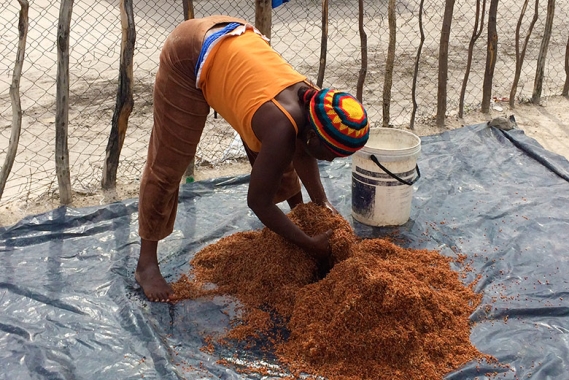Sorghum: the magic plant!

Practically every third stall at the local market was selling sorghum. I had heard of this plant before, but in Namibia I learned just how versatile and important it is in sub-Saharan Africa. You can make Sorghum into a flour, into ethanol, you can use it as a sweetener or feed it to livestock; so what exactly is it you may ask? Well, sorghum can be used for all of these purposes and more.
 This multipurpose plant grows as tall as corn in dry climates, making it a perfect crop to tolerate stressful conditions in sub-Saharan Africa. The plant’s waxy thin leaves have tiny pores which conserves water and its roots grow deep in dry soil, increasing the sorghum’s ability to mine for water.
This multipurpose plant grows as tall as corn in dry climates, making it a perfect crop to tolerate stressful conditions in sub-Saharan Africa. The plant’s waxy thin leaves have tiny pores which conserves water and its roots grow deep in dry soil, increasing the sorghum’s ability to mine for water.
When I visited the SOS Family Strengthening program at my village, I was introduced to a microfinance project where SOS provides support to vulnerable families. These projects teach caregivers how to run a business, make a profit and become self-reliant. One of the microfinance programs offered in SOS Namibia was growing and selling sorghum. Beneficiaries of the program sell sorghum in the form of flour at the market, and also use it for a bread-baking business (another Family Strengthen Program initiative in Namibia).
 Sorghum is not a wheat, meaning that it is gluten-free – another benefit of this magic plant. Since the vast majority of sub-Saharan Africa does not have mechanised farming, the process of turning the plant from grain to flour is tedious. First, you have to sort the grain, soak it in water until it has softened, and then pound it with a large wooden pestle. This process, which is repeated several times, removes the hard outer-layer of the grain. It is then spread out to dry under the scorching Namibia sun. Once the sorghum has dried, it is hand pounded again and again. The process is very labour intensive and definitely provides a good upper body workout!
Sorghum is not a wheat, meaning that it is gluten-free – another benefit of this magic plant. Since the vast majority of sub-Saharan Africa does not have mechanised farming, the process of turning the plant from grain to flour is tedious. First, you have to sort the grain, soak it in water until it has softened, and then pound it with a large wooden pestle. This process, which is repeated several times, removes the hard outer-layer of the grain. It is then spread out to dry under the scorching Namibia sun. Once the sorghum has dried, it is hand pounded again and again. The process is very labour intensive and definitely provides a good upper body workout!
 I had the opportunity to pound the sorghum into a flour to bake bread. While I often bake at home for my family, I have never done it this way. You can see me laughing in these pictures—but in reality, I was trying really hard to do my job properly! The strenuous process heightened my appreciation of just how hard people in this region of the world work to feed their families. I was told that for every 1.5 kilograms of flour produced, it takes the women almost an hour to grind the grain. Just after several minutes, I felt my arms melt into Jell-O.
I had the opportunity to pound the sorghum into a flour to bake bread. While I often bake at home for my family, I have never done it this way. You can see me laughing in these pictures—but in reality, I was trying really hard to do my job properly! The strenuous process heightened my appreciation of just how hard people in this region of the world work to feed their families. I was told that for every 1.5 kilograms of flour produced, it takes the women almost an hour to grind the grain. Just after several minutes, I felt my arms melt into Jell-O.
